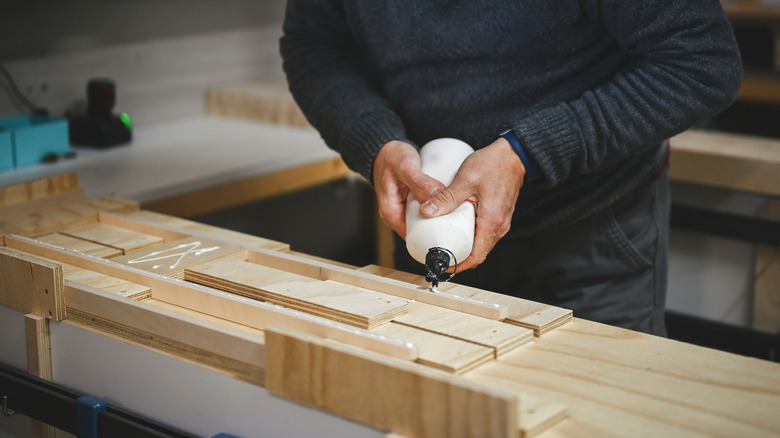The Easy Hack For Cleaning Up Excess Glue On Your Home Wooden DIY Projects
Paul Sellers is the kind of old-school guy you might be surprised to find on TikTok. At 74 years old, Sellers has become something of a woodworking guru, with two pieces in the White House's permanent collection, displayed in the Cabinet Room. He offers masterclasses focusing on woodworking with hand tools, and on his blog, he talks about sometimes using handsaws and planes for six hours straight. But he's been dedicated to online communication since launching his YouTube channel in 2011. So when Sellers posts a TikTok telling you to clean up excess wood glue using wood shavings, you can be sure this isn't some suspect TikTok trickery.
In his video, Sellers scrubs an edge-glued board to soak up wood glue that has squeezed out during clamping, but of course, the trick would work on any glue-up. The average home woodworker might have already spotted the potential flaw in Sellers' plan for easing their glue squeeze-out woes: not every woodworker has a fistful of wood shavings sitting around. Sellers does. In fact, he has a YouTube video about how to reduce the volume of an entire garbage bag full of wood shavings that "just came from hand planing." For better or worse, most woodworkers might not produce that volume of shavings in a month, much less an afternoon. But this is a great tip, and Sellers is giving you a good reason to stockpile shavings rather than sweeping them off to the dump.
Glue cleanup with shavings, sawdust, and straws
It seems likely that the shavings would simply spread some of the glue around rather than removing it, but it would doubtless be a very small amount spread over a large area. And remember who we're talking about here; the odds that Sellers will hand-plane the board flat (thereby removing any glue residue) is surely about 100%. Running it through a planer or a light sanding would also do the trick. The hack also eliminates a rag to wash or a paper towel to throw away, and it doesn't require that you expose your unfinished work to the water often used in glue cleanup.
Of course, none of those benefits will help you much if you don't have any wood shavings handy. But that's not the end of the story, because the fortuitously named Sawdust Society says in a YouTube video that you can do much of the same work using mere sawdust, which every woodworker has in plentiful supply. Simply cover the glue squeeze-out with sawdust, lightly press with your fingers so the sawdust can grab onto the glue, then scrape it away with the back side of a chisel blade. This trick also works great in corners where it might be difficult to work with large shavings. And there's a bonus: if you happen to need it, you've just used the sawdust to create your own homemade wood filler.
